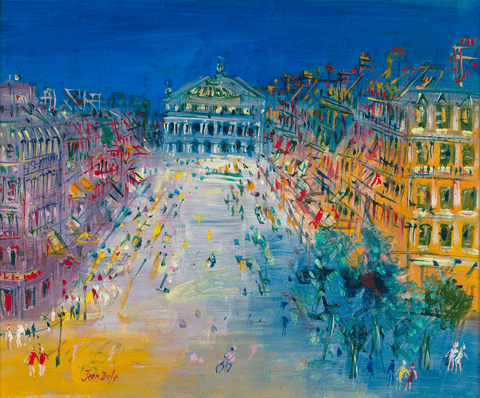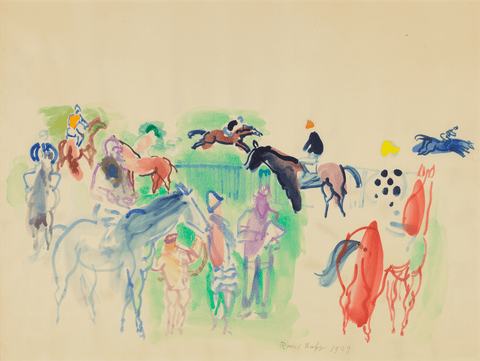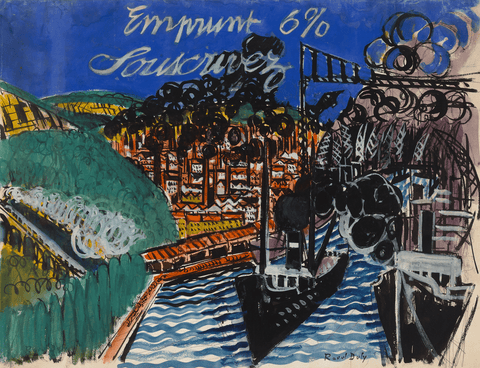Artists & Artisans
Dufy, Raoul
French Fauvist artist Raoul Dufy (1877-1953) is celebrated for his whimsical, uniquely stylized paintings that are immediately recognizable for their vibrant palettes and jubilant subjects. The artist's explosive use of color and spontaneous, playful lines make his work uplifting to such an extent that Gertrude Stein wrote in 1946, “...One must meditate about pleasure. Dufy is pleasure.”
Using “stenographic” outlines to define the figures and objects in his compositions, he applied delicate washes of oil paint that resemble watercolor or gouache to his canvases, enhancing their sense of joie de vivre. Appropriately, Dufy's subjects were exclusively devoted to pleasure scenes, including sailing ships, chic parties, views of the French Riviera, social events, lavish interiors, horse races, seaside views, and more.
Born in 1877 in Le Havre, Normandy, Raoul Dufy was the eldest of nine children. He enrolled in evening art classes as a young artist, where he was taught by a former student of the Neoclassical master Jean-Auguste-Dominique Ingres. After his military service, Dufy secured admission to Paris' École Nationale Supérieure des Beaux-Arts, where he befriended fellow student and future Cubist painter Georges Braque.
Initially painting in an impressionistic style inspired by Impressionist painters such as Claude Monet and Camille Pissarro, the artist gained immediate entrée into the art world, exhibiting work at the Salon des Indépendants, Berthe Weill Gallery, and the Exhibition of French Artists. 1905 proved to be a defining moment for Dufy; it was then that he first encountered the work of Henri Matisse, which inspired him to fully embrace the emotional impact of color and pushed him towards Fauvism. Les fauves, French for “wild beasts” was an art movement that loosely included Henri Matisse, Albert Marquet, and Georges Braque, and was characterized by its use of intense color.
For the next couple of decades, Dufy worked not only as an artist, but as a designer as well. He explored and gained recognition for textile designs, printmaking, set design, tapestries, ceramic designs and more all in his signature decorative style. The artist's understanding of decorative techniques and aesthetics helped to shape his painting style, which developed more fully around 1920. The artist took on significant commissions, including the monumental and noteworthy La Fée Électricité for the 1937 Exposition Internationalle, which now resides in the National Museum of Modern Art in Paris. This masterpiece measures approximately 6500 square feet.
The French artist continued to exhibit and win awards both in France, such as at the annual Salon des Tuilleries, and abroad. In 1952, Dufy was honored with the Grand Prize for painting at the prestigious Venice Biennale, a major late career achievement for the artist. By this time, he suffered from severe arthritis, particularly in his hands, making it excruciating for him to produce new work. Having undergone experimental treatment for his arthritis, the artist ultimately died of intestinal bleeding in March of 1953 in Forcalquier, France.
Raoul became a mentor to his younger brother Jean Dufy (1888-1964), who followed in Raoul's footsteps as an artist, stylistically emulating Raoul's distinctive version of decorative Fauvism.
Raoul Dufy's legacy is most closely tied to his beloved paintings, which are in the collections of many major museums. On occasion, however, his design work reemerges, such as in the Metropolitan Museum's 2007 exhibition Poiret: King of Fashion, which included a section of designs utilizing textiles by Dufy.
Dufy’s work remains highly coveted by fine art collectors worldwide. M.S. Rau proudly offers a curated selection of Raoul Dufy original paintings for sale. For more information, please contact us today.
Artists & Artisans
Dufy, Raoul
French Fauvist artist Raoul Dufy (1877-1953) is celebrated for his whimsical, uniquely stylized paintings that are immediately recognizable for their vibrant palettes and jubilant subjects. The artist's explosive use of color and spontaneous, playful lines make his work uplifting to such an extent that Gertrude Stein wrote in 1946, “...One must meditate about pleasure. Dufy is pleasure.”
Using “stenographic” outlines to define the figures and objects in his compositions, he applied delicate washes of oil paint that resemble watercolor or gouache to his canvases, enhancing their sense of joie de vivre. Appropriately, Dufy's subjects were exclusively devoted to pleasure scenes, including sailing ships, chic parties, views of the French Riviera, social events, lavish interiors, horse races, seaside views, and more.
Born in 1877 in Le Havre, Normandy, Raoul Dufy was the eldest of nine children. He enrolled in evening art classes as a young artist, where he was taught by a former student of the Neoclassical master Jean-Auguste-Dominique Ingres. After his military service, Dufy secured admission to Paris' École Nationale Supérieure des Beaux-Arts, where he befriended fellow student and future Cubist painter Georges Braque.
Initially painting in an impressionistic style inspired by Impressionist painters such as Claude Monet and Camille Pissarro, the artist gained immediate entrée into the art world, exhibiting work at the Salon des Indépendants, Berthe Weill Gallery, and the Exhibition of French Artists. 1905 proved to be a defining moment for Dufy; it was then that he first encountered the work of Henri Matisse, which inspired him to fully embrace the emotional impact of color and pushed him towards Fauvism. Les fauves, French for “wild beasts” was an art movement that loosely included Henri Matisse, Albert Marquet, and Georges Braque, and was characterized by its use of intense color.
For the next couple of decades, Dufy worked not only as an artist, but as a designer as well. He explored and gained recognition for textile designs, printmaking, set design, tapestries, ceramic designs and more all in his signature decorative style. The artist's understanding of decorative techniques and aesthetics helped to shape his painting style, which developed more fully around 1920. The artist took on significant commissions, including the monumental and noteworthy La Fée Électricité for the 1937 Exposition Internationalle, which now resides in the National Museum of Modern Art in Paris. This masterpiece measures approximately 6500 square feet.
The French artist continued to exhibit and win awards both in France, such as at the annual Salon des Tuilleries, and abroad. In 1952, Dufy was honored with the Grand Prize for painting at the prestigious Venice Biennale, a major late career achievement for the artist. By this time, he suffered from severe arthritis, particularly in his hands, making it excruciating for him to produce new work. Having undergone experimental treatment for his arthritis, the artist ultimately died of intestinal bleeding in March of 1953 in Forcalquier, France.
Raoul became a mentor to his younger brother Jean Dufy (1888-1964), who followed in Raoul's footsteps as an artist, stylistically emulating Raoul's distinctive version of decorative Fauvism.
Raoul Dufy's legacy is most closely tied to his beloved paintings, which are in the collections of many major museums. On occasion, however, his design work reemerges, such as in the Metropolitan Museum's 2007 exhibition Poiret: King of Fashion, which included a section of designs utilizing textiles by Dufy.
Dufy’s work remains highly coveted by fine art collectors worldwide. M.S. Rau proudly offers a curated selection of Raoul Dufy original paintings for sale. For more information, please contact us today.






